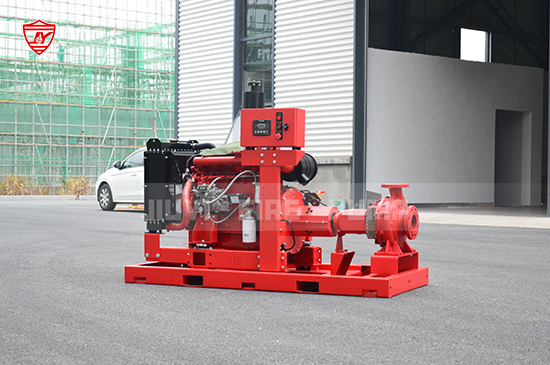When people think of fire safety systems, they often picture alarms, sprinklers, or extinguishers. However, one of the most critical—but often overlooked—components is the fire pump. As a manufacturer of fire pumps, one of the most common questions we hear is: Does every building have or need a fire pump?

The answer isn’t as simple as “yes” or “no.” Whether a fire pump is required depends on several factors including building size, height, water supply pressure, and local fire codes. In this article, we’ll explore:
What fire pumps do and why they matter
The types of buildings that typically require fire pumps
Regulatory frameworks like NFPA 20
How to assess whether your facility needs a fire pump
Common misconceptions about fire pumps
The consequences of not having one when it’s required
A fire pump is a part of a building’s fire protection system. Its role is to boost water pressure to fire suppression systems such as sprinklers, hose reels, or standpipes, especially when the normal water supply lacks sufficient pressure or flow.
Without a fire pump, these systems might not operate effectively during an emergency—leading to property damage, operational downtime, or even loss of life.
High-rise buildings often need fire pumps because water pressure from the municipal supply cannot adequately reach upper floors. Generally, if your building is over three stories or more than 60 feet tall, a fire pump is likely required.
Buildings with extensive sprinkler systems, foam systems, or standpipe systems may need a fire pump to maintain required pressure levels, regardless of building height.
If a building is located in an area with low water pressure, even a single-story facility may need a fire pump. This is common in rural areas or industrial zones.
Different jurisdictions have different fire safety codes. Many follow or adapt NFPA 20, which specifies when and how fire pumps should be installed. Always check with your Authority Having Jurisdiction (AHJ) or local fire marshal.
High-Rise Apartments and Condominiums
Hospitals and Healthcare Facilities
Shopping Malls and Large Retail Stores
Hotels and Convention Centers
Manufacturing Plants and Warehouses
Data Centers and Server Rooms
Airports and Transportation Hubs
Schools and Universities with Large Campuses
Even if not strictly required, many building owners choose to install fire pumps as a proactive safety measure.
The National Fire Protection Association (NFPA) 20 is the leading standard governing the installation of fire pumps. It covers everything from pump types and power sources to installation requirements and testing procedures.
Key NFPA 20 considerations include:
Fire pumps are required when water pressure is insufficient to meet system demand
The fire pump system must include a reliable power source (diesel engine, electric motor, or both)
Pumps must be tested regularly for operational readiness
Controllers and jockey pumps must be integrated properly
UL-listed fire pumps and NFPA 20-compliant systems, like those we manufacture, ensure full regulatory compliance and long-term reliability.
Here are a few steps that building owners and facility managers can take:
Conduct a Hydraulic Calculation
Work with a fire protection engineer to calculate the water pressure and flow required for your building’s suppression systems.
Assess the Local Water Supply
Measure the static and residual water pressure at your site. If it’s too low, you’ll likely need a fire pump.
Review Building Type and Use
Certain occupancies (like hospitals and data centers) have higher fire protection requirements regardless of water pressure.
Check Local Regulations
Contact your local AHJ for specific code requirements in your area.
Consult a Fire Protection Contractor
A licensed contractor can provide design recommendations and help you select the right fire pump package.
Failing to install a required fire pump can result in:
Code Violations and Fines
Your building may be deemed non-compliant, leading to financial penalties or occupancy restrictions.
Insurance Issues
Many insurers require compliance with NFPA standards. Lack of a fire pump may void your fire coverage or increase premiums.
Safety Hazards
Most importantly, an underperforming fire system can put lives at risk and increase fire damage.
Myth 1: Only large buildings need fire pumps.
Not true. Even smaller buildings can require a fire pump if the water supply is insufficient.
Myth 2: If sprinklers are installed, no fire pump is needed.
Incorrect. Sprinklers need pressure to work effectively, which is often provided by a fire pump.
Myth 3: Fire pumps are always diesel-powered.
Fire pumps can be powered by electric motors, diesel engines, or even dual-drive systems.
Myth 4: Fire pumps run all the time.
Fire pumps only activate during an emergency or during a routine test. A jockey pump maintains pressure in the system during standby.
While not every building has a fire pump, many should. Whether required by code or installed for additional safety, fire pumps are a vital component of modern fire protection systems.
If you’re unsure whether your building needs one, Better Technology Group is here to help. We provide:
UL-listed fire pump packages
Diesel, electric, and jockey pumps
Vertical turbine and end suction types
Custom-designed solutions for your application
NFPA 20 compliant systems
Expert consultation and global support